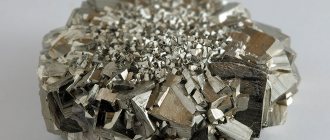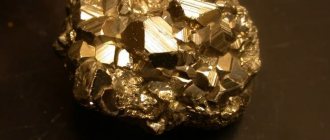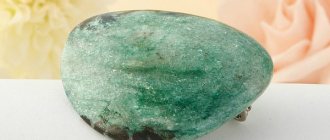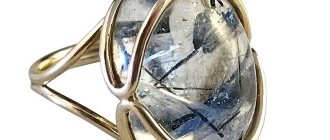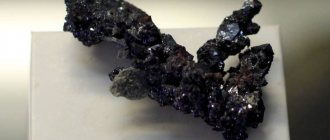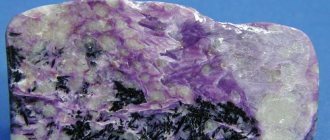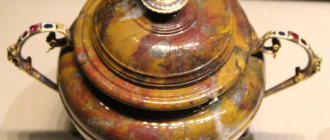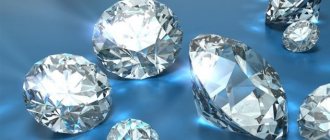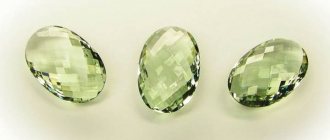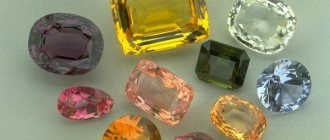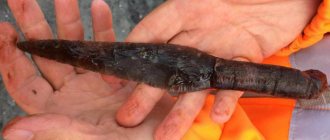Among the properties of pyrite stone, not only its similarity with a noble metal is noteworthy. There is also a practical thing: you can make sparks with it. Therefore, in the old days, the mineral was used instead of matches and lighters. Actually, its name just means “flint” in translation from Greek. In the scientific community, the name is more prosaic - sulfur, or iron pyrite.
History and origin
Translated from Greek, pyrite means “stone that creates fire.” It received this name for its ability to spark when struck. This useful feature placed the lighter mineral above gold.
Pyrite
The Incas of pre-Columbian America used a stone with shiny edges as a magic mirror; the Indians considered it an amulet against alligators.
Pyrite clouded the minds of the Spanish conquistadors: mistaking the mineral for gold, they took it from local residents by force or deception. And in their homeland they were made fools by showing off the pyrite gold of the Incas under the guise of a noble metal.
Prospectors from the Alaska Gold Rush were in trouble. Thus, the names “Inca gold” and “fool’s gold” were assigned to pyrite.
The mineral “golden” pyrite was exalted during the reign of Napoleon. It was awarded to ladies who donated jewelry to the fighting army. It was a badge of honor; patriotic French women were proud of such accessories.
The 20th century was a turning point for the mineral. British designers Butler and Wilson were visited by fresh ideas, their exclusive products became very popular and made the “golden” stone a favorite of bohemia.
Pyrite is formed as a result of magmatic or hydrothermal processes, at the bottom of closed sea basins, in the copper-nickel formation.
Igneous rocks are rich in small crystals; the largest cubes hide quartz veins.
In what form does the mineral occur in nature?
In most ores and rocks, pyrite is found in the form of rounded grains or crystalline inclusions. Often there are solid aggregate masses, sometimes forming druses.
The most common are cubic or pentagondodecahedral/octahedral crystals. There are crystals whose dimensions reach several decimeters in cross section. They are characterized by hatched edges (the strokes form parallels with the edges of the cubes). Such stripes are always oriented perpendicular to adjacent faces, in accordance with the structural features of the mineral sample.
Often in nature, pyrite deposits grow together with tetrahedrites, marcasites, pyrrhotites and galenas. Pyrite crystals, formed under the influence of high or low temperatures, take the shape of an octahedron or cube. But the formation of simple forms under intermediate temperature conditions turns out to be an order of magnitude richer.
Pentagondodecahedral formations are considered typical of low-temperature, highly mineralized zones. But the pentagododecahedral habit is formed under conditions of intermediate temperatures. Cubic pyrite habitus is a typical example of formation at low supersaturation, and pentagondodecahedral - at high supersaturation, respectively.
Physicochemical characteristics
Pyrite is the most common sulfide. The crystal cubes have smooth edges and seem to have a hatched pattern on the surface.
| Formula | FeS2 |
| Color | Straw yellow, brass yellow, golden yellow, sometimes tarnished |
| Shine | Metal |
| Transparency | Opaque |
| Hardness | 6-6,5 |
| Cleavage | Very imperfect by {001} |
| Kink | Conchoidal |
| Density | 5.01 |
The hue and luster are visually identical to gold or silver, which once puzzled mineralogists. They spent a long time deciding whether it was stone or metal.
Pyrite stone
The dominance of sulfur and iron, as indicated by the chemical formula of the substance, led to other names for pyrite - sulfur pyrite and iron pyrite.
Pyrite for women
Despite the fact that Mars is considered the ruler of the stone, pyrite is not an exclusively male talisman. In Greek mythology, the beloved of Ares (Mars) was Aphrodite, the goddess of love and beauty, therefore esotericists attribute the ability to “iron pyrite” to harmonize family relationships.
It makes women attractive, cheerful, healthy and young. Strengthening the nervous system and gaining control over emotions is a real gift for the fair sex.
Pyrite is an ideal talisman for a modern businesswoman, a determined and independent woman of the 21st century. At the same time, “Inca gold” heals infertility, helps to bear a healthy child and create a strong family.
Place of extraction
Pyrite is found almost everywhere on the planet. The largest deposits of the mineral are in Russia (Ural) and the USA. Small accumulations are found in Europe.
Specimens in condition suitable for processing and use are rare. Almost everything is supplied by Italy. In South Africa, material with uranium impurities is mined.
The shine of pyrite layers means the presence of gold nearby. This proximity makes the mineral look like a noble metal.
Pyrite can be found near hot springs. The stone is not mined separately, but is extracted from ore containing cobalt, zinc or copper.
Mineral deposits
Pyrite cubes in rock
Pyrite is not specifically mined, as it is economically unjustified. It is obtained by working with pyrite ore during the extraction of more valuable rocks - lead, copper, tin, zinc and other non-ferrous metals.
In nature, the mineral looks like a cluster of smooth and shiny cubes with clear edges. Jewelry samples are supplied mainly from Italy. Russia, the USA, Canada and Japan use the “mined” mainly for industrial purposes, obtaining sulfur, sulfuric acid and ferrous sulfate from the mineral, and also as a corrective additive in the process of cement production. There are also pyrite deposits in Spain, Kazakhstan and Norway.
Varieties and colors
Pure sulfur pyrite is rare. More often, impurities create a range of stones from barely noticeable yellowish to golden yellow.
Types of mineral:
- bravoite - thick yellowness comes from nickel (up to 20% of the composition), a jewelry variety;
Bravoite mineral - marcasite - metallic shiny “drop silver” plus shimmer on a slightly yellowish background; It oxidizes easily, so it is not suitable for jewelry.
Mineral marcasite
Visual differences are created not only by impurities, but also by the lattice structure. Thus, marcasite is characterized by syngony, so the crystals resemble rays.
Medicinal properties
The external resemblance to gold determined the healing properties of the stone.
Pyrite heals the soul and body, acting on a deep level. It cleanses and strengthens the human biofield, so even severe or chronic illnesses recede.
The mineral is applied to the problem area, from which it “pulls” bad energy. Helps with the following problems:
- infertility;
- infections, viruses;
- joint pain;
- skin fungus;
- freckles;
- cataract;
- decreased muscle tone.
By accelerating blood circulation, the stone stimulates the functioning of the cardiovascular system and lungs. Healers advise tying it to a woman’s leg to facilitate childbirth.
The mineral improves sleep and performance; it is suitable for people with a hectic pace of life or those engaged in routine hard work.
This is a natural antidepressant, but overly emotional people need to be careful with it.
What names is it suitable for?
The mineral makes good contact with the following female names: Angelica, Sabina, Aksinya, Valeria, Nina.
Pyrite will help bearers of names become more attractive and sexy. It will increase the level of spirituality, morality and give confidence in your own actions.
You can take the stone with you on a date so that your partner experiences a stronger attraction. It’s better to wear the stone for several days before the scheduled meeting.
Among men, the stone interacts well with those named Peter, promotes the development of courage, boldness and imparts powerful strength.
Magic properties
Roman legionnaires and Greek warriors considered pyrite theirs. It was believed that this stone was the earthly embodiment of the god of war, Mars, and an amulet with it made the owner brave and protected from wounds.
The magical properties of the stone are also valued in the peaceful sphere. Sorcerers, psychics, and their other practicing colleagues do not skimp in order to take possession of an impeccable copy. Only a pebble with a smooth, solid surface, without chips or cracks, restores strength. Defective minerals attract problems.
Shiny pyrite crystals are powerful helpers for various purposes:
- peace of the family hearth, revival of marital feelings;
- success on the love front;
- eliminating conflicts at work and at home;
- protection from the elements;
- energy supply at the mental and physical levels;
- concentration for action in extreme situations.
Pyrite amulet
Pyrite cubes are talismans and amulets for people in risky professions: police officers, emergency workers, hot shop workers, firefighters, stuntmen. The owners of such a talisman become calmer and more resilient.
The stone is suitable for real and potential leaders.
However, this is a “highly moral” mineral; its magic only helps in actions with a plus sign. Liars, cunning people, dishonest people risk having the negative message sent back. In a favorable scenario, the value of the stone for them will be zero.
Talismans and amulets
"Pyrite dollar", mined in Arizona, diameter 10 cm
Pyrite has a fiery nature and powerful energy.
As a permanent talisman, it is suitable only for strong-willed people who can withstand its power. The rest of the applicants should wear the stone for no more than three days in a row or keep it at home, turning to its magic only when necessary.
Iron pyrite will be an excellent amulet for people who often risk their lives in their line of work - military personnel, rescuers, high-altitude installers, stuntmen, firefighters, testers and builders. He will protect them and warn them of approaching dangers, unexpectedly revealing his weight.
The second category of pyrite’s “favorites”, for whom it can become an indispensable assistant, are all kinds of representatives of the law - law enforcement officers, judges, lawyers, advocates, and so on. The stone will help them quickly reveal the truth, stand up for the weak and disadvantaged, and make a fair decision regarding the guilty.
Iron pyrite is a reliable protector of the house and its inhabitants. He is able to “kick” residents out into the street if some kind of disaster is looming, and also warn in dangerous moments, for example, if a fire occurs. The stone also “does not allow” bad people inside who wish harm to its owners.
Pyrite can act as a love talisman. It helps to find a soul mate faster, pushes people if they are made for each other, ignites passion, even among married couples who have lived together for quite a long time, whose feelings have practically faded away.
Who is suitable according to their zodiac sign?
Energetically strong pyrite is patronized by the powerful Mars and Neptune. Not every zodiac sign can use the stone.
If a person’s work is monotonous or calm, but according to the horoscope there are no obstacles, moderate use of the stone is acceptable.
| Zodiac sign | Compatibility |
| Aries | +++ |
| Taurus | + |
| Twins | + |
| Cancer | — |
| a lion | +++ |
| Virgo | + |
| Scales | + |
| Scorpion | + |
| Sagittarius | +++ |
| Capricorn | + |
| Aquarius | + |
| Fish | + |
(“+++” – fits perfectly, “+” – can be worn, “-” – is strictly contraindicated)
Compatibility with other stones
Pyrite is a mineral of the fire element. Of the precious and semi-precious stones, only hematite and serpentine can be neighbors in jewelry or a box. The rest will be crushed by the powerful energy of the “golden” mineral.
For those who are indifferent to the magical properties of natural pyrite, jewelers offer multi-colored jewelry. In them, pyrite inserts or elements are aesthetically complemented with inexpensive gems: pressed turquoise, cultured pearls, garnet, jasper.
Pyrite and Feng Shui
The magical properties of the stone are recognized as effective for attracting good luck, money, and family well-being.
Figurines, slides, and coins are made from stone, which embodies the element of Fire. Suitable for residential or office space.
Pyrite decor is placed in places with poor energy or special areas:
- achieving prosperity - in the southeast;
- house security - a sphere or cube at the entrance.
Chinese pyrite coins in a purse or handbag will attract confidence, help you overcome financial problems, and solve problems of any complexity. The low cost of pyrite makes it accessible to everyone. A large golden specimen with a metallic sheen will add respectability to the interior.
Application and Use
The physical properties of pyrite determined the areas of its use.
Industry
The main field of application of the stone. The mineral is used in the production of concrete, iron sulfate, cement, mastics, and steel.
Once upon a time, alchemists deceived powerful patrons with a “golden” stone. Modern adherents of this science are not interested in him. The idea of extracting gold from pyrite is utopian: it was found that there is as much of it as in the human body.
Jewelry
The material used in jewelry is structurally flawless and effective.
It is used to make pendants, necklaces, bracelets, and earrings for women. They are appropriate in the office, at a party or for a walk. The frames are bronze, brass, jewelry alloy and cupronickel.
Crystalline pyrite is a fertile material for men's assortment. A bracelet, pendant or pendant with minimal stone processing is truly brutal sophistication.
Collection material
Minerals with tarnish are prized by collectors. This is a real rainbow stone - it shimmers with all the colors of the solar spectrum. For example, copper impurities give a blue tint.
Pyrite bracelet
Yellow, green, brown fragments on the surface are the result of other elements in the composition of the mineral.
Price
Pyrite is inexpensive and is priced per gram or kilogram. The price of the product depends on the degree of processing:
- non-jewelry raw materials - $22–26 per kg;
- tumbling 12–45 mm – $40–45 per kg;
- beads about 40 cm long - $11 (2 mm), $8 (6 mm);
- figurine 15x8 cm - $200–250.
The ornamental mineral is difficult to process, so small beads are more expensive than large ones.
Cost of pyrite samples
It’s worth starting with unprocessed crystals, which at current prices cost 1000 rubles per 2 cm3 cube. This is a good option for mineralogical collections.
Pyrite beads, collected in threads approximately 40 cm long, cost about 900-1000 rubles with a bead diameter of up to 7 mm. The stone is often used to make “ritual,” sacred and “magical” figurines.
So a Buddha figurine 15 centimeters high and about 8 centimeters wide can cost from 12 to 15 thousand rubles. Since the times of the ancient Chinese dynasties, pyrite has been famous among Asian peoples as a special stone that has become a symbol of well-being, wealth and prosperity.
How to spot a fake
The cost of pyrite is affordable, but instead they offer plastic or glass with a shiny coating. In turn, the mineral is passed off as gold.
It is easy to distinguish pyrite from imitation:
- Evaluate for clarity. A real mineral is always impenetrable.
- Scratch the sample with your fingernail. Spraying on the imitation will do.
- Run the sample across the glass. Pyrite will scratch it without any problems.
To avoid buying a stone at the price of gold, just press on the surface or try on your tooth. Soft gold will leave a dent; hard pyrite does not have this property.
Shambhala made of pyrite
The characteristics of the mineral exclude fine processing. Jewelry made from pyrite is not elegant and filigree. They're rough, but they look great. This differentiates processed pyrite from gold or plastic.
Interesting Facts
Pyrite is a unique natural formation, as proven by the following facts:
- The only sulfide that easily scratches glass.
- Can't stand emptiness. Fills any cavities in rocks and even organic matter - penetrates into shells of mollusks and trunks of dead trees.
- It is the most common sulfide;
- “Tells” geologists where to look for gold, as it often lies next to this precious metal.
- Does not need sanding. Nature has polished it so well that you can immediately insert the mineral into jewelry.
- The stone has such a strong shine that the ancient Greeks took it into battle to blind the enemy.
“Golden Stone” ignites fire, looks like gold, heals and bewitches. It has long been famous as an amulet that attracts wealth. Although pyrite is one of the ten most dangerous minerals, people continue to believe in its supernatural abilities - they buy and wear shiny bracelets, keep figurines of money frogs at home, and the mysterious crystal has not yet disappointed anyone.
How to wear and care
The energy of the stone is such that strong-willed people can constantly interact with it.
For the rest, esotericists recommend wearing jewelry for no more than three days in a row. Otherwise, a nervous breakdown, irritability, even insanity are guaranteed.
The mineral is delicate; the following are contraindicated:
- falls, mechanical impacts;
- prolonged exposure to the sun;
- household chemicals;
- proximity to other stones.
Even ordinary conditions are not suitable: within a few years, untreated pyrite crumbles in air. This is probably where the legends about old pirate treasures that became dust came from. The earth or deep sea destroys the mineral faster.
For safety, experts recommend covering dry items or crystals in jewelry that are free of oxides and dirt with colorless nail polish or soaking them in vegetable oil. Owners of pyrite items say that in this form they retain their original appearance and last for many years
.
Caring for collectible exhibits is troublesome. Oxygen in the air decomposes the mineral, and water that gets on the stone creates sulfuric acid, which is destructive to the exhibit.
Pyrite bracelet
Therefore, it is better to store fossils with pyrite in vacuum packaging. It's expensive and not available to everyone. It is cheaper, following the example of museum workers, to boil it over low heat in paraffin or rosin. The procedure can be done at home, but only a vacuum provides a complete guarantee of the safety of structurally heterogeneous samples.
Characteristic signs for the diagnostic determination of a mineral
As already described above, the mineral has unique crystal shapes and is perfectly recognizable by the color and characteristic streakiness of the crystalline faces. Also among sulfides, the mineral has the highest degree of hardness and is capable of scratching glass.
All of these features together clearly distinguish pyrite from some minerals that are very similar in appearance and color, including pyrrhotite, chalcopyrite, marcasite, millerite, and arsenopyrite.
If we talk about the non-specific form of crystals and aggregate forms, then externally pyrite is practically indistinguishable from marxite. Chalcopyrite, which is very similar in appearance to pyrite samples, has a lower density (up to 4 Mohs units) and a more pronounced yellowness. Cobaltine has even less hardness, but does not have a yellow tint, like pyrite. Pyrrhotite has a darker shade, and gold, with which the mineral is very often confused to this day, has a yellow streak versus the grayish-black streak of pyrite.
